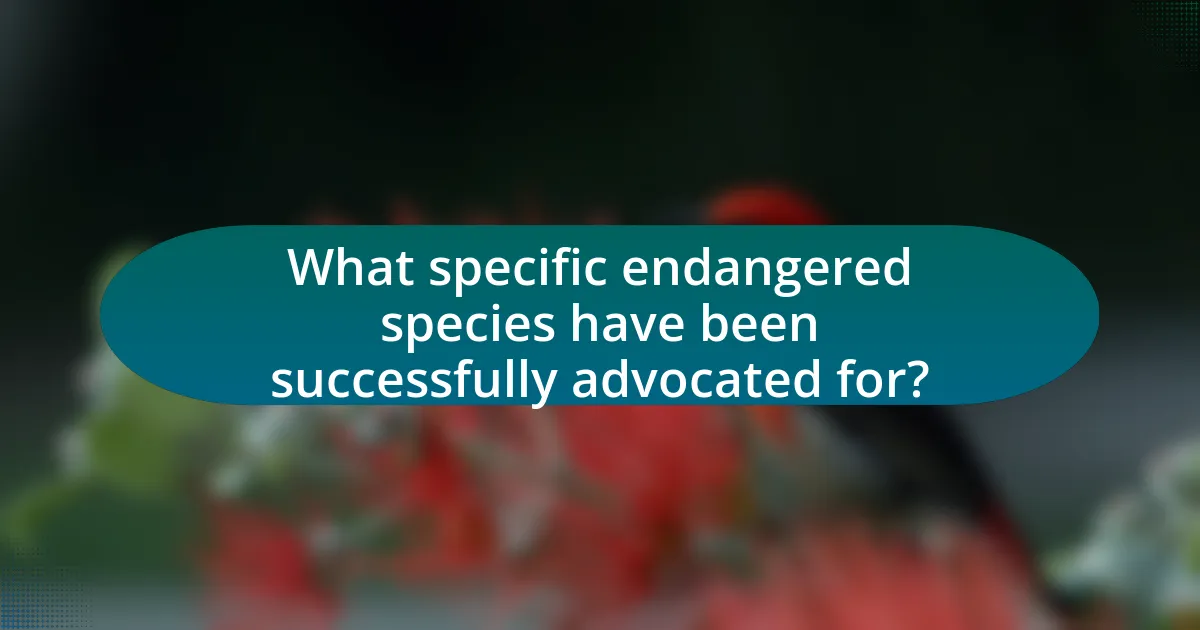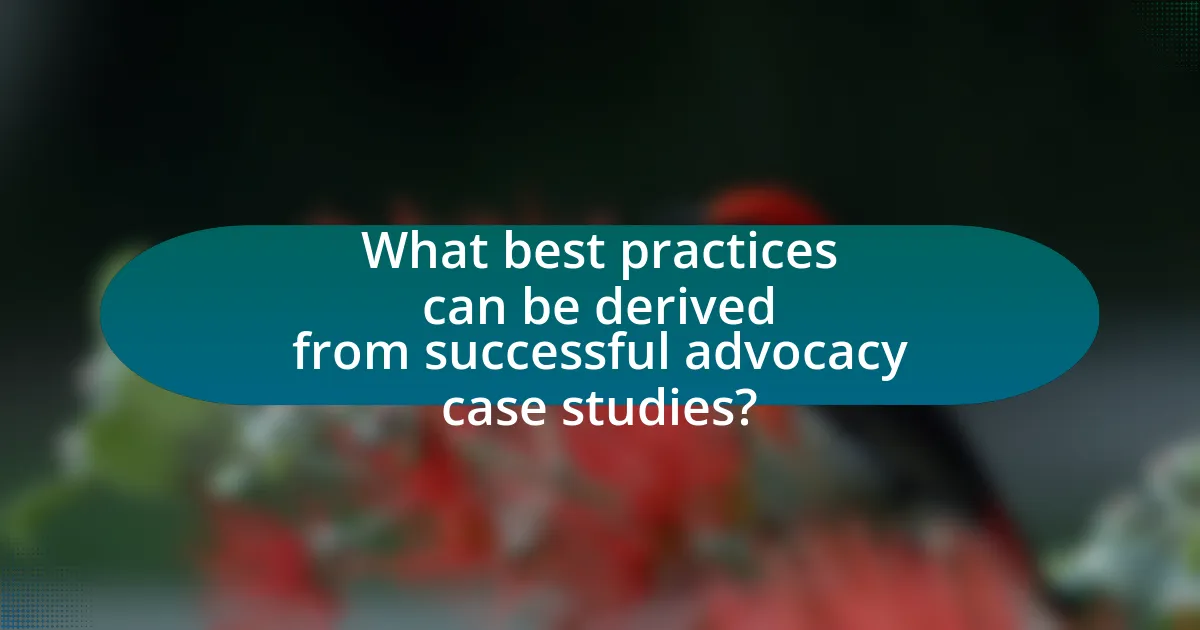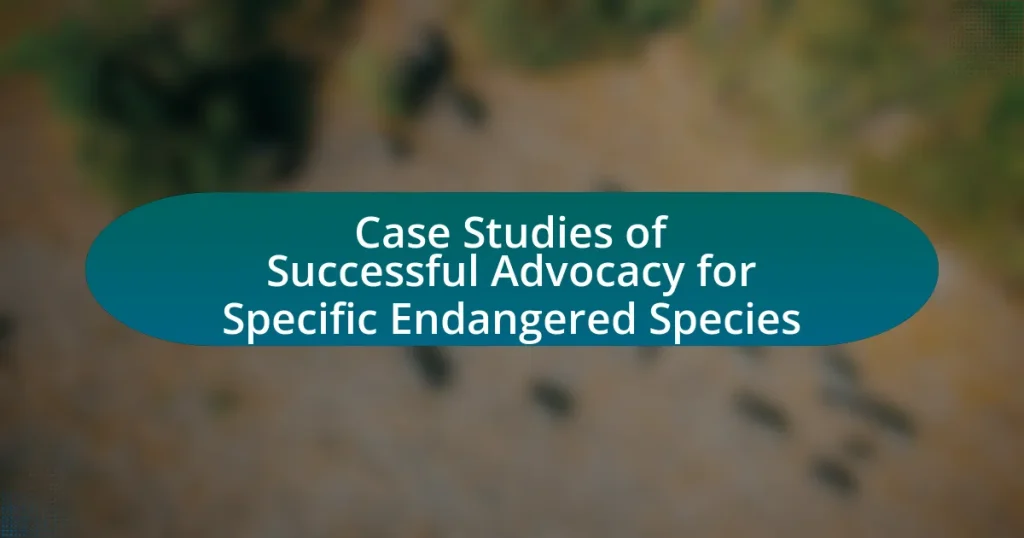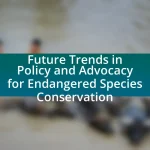The article focuses on case studies of successful advocacy for specific endangered species, highlighting notable recoveries such as the American bald eagle and the California condor. It examines effective advocacy strategies, including grassroots mobilization, targeted lobbying, and public awareness campaigns, which have led to significant population increases and habitat protections. The article also discusses the challenges faced in these advocacy efforts, the importance of community involvement, and the measurable outcomes achieved through these initiatives. Additionally, it outlines best practices and resources available for future advocacy efforts, emphasizing the role of collaboration and data-driven approaches in enhancing conservation outcomes.

What are Case Studies of Successful Advocacy for Specific Endangered Species?
Case studies of successful advocacy for specific endangered species include the recovery of the American bald eagle, which was removed from the endangered species list in 2007 due to concerted conservation efforts. These efforts included banning the pesticide DDT, habitat protection, and public education campaigns, resulting in a population increase from fewer than 500 breeding pairs in the 1960s to over 10,000 pairs today. Another example is the successful advocacy for the California condor, which saw its population drop to just 27 individuals in the 1980s. Intensive breeding programs, habitat restoration, and legal protections led to a population of over 500 condors by 2021, demonstrating the effectiveness of targeted advocacy and conservation strategies.
How do these case studies illustrate effective advocacy strategies?
These case studies illustrate effective advocacy strategies by demonstrating targeted approaches that mobilize community support, leverage scientific research, and engage policymakers. For instance, the case of the California condor highlights how grassroots campaigns raised awareness and funding, resulting in successful breeding programs that increased the population from 27 individuals in 1987 to over 500 today. Similarly, the advocacy for the northern white rhino showcases the use of international coalitions and social media to galvanize global attention and resources, leading to innovative conservation techniques. These examples validate that successful advocacy combines local engagement with broader strategic initiatives, effectively influencing conservation outcomes.
What specific advocacy techniques were employed in these case studies?
The specific advocacy techniques employed in the case studies include grassroots mobilization, targeted lobbying, public awareness campaigns, and coalition building. Grassroots mobilization involved engaging local communities to participate in conservation efforts, which increased public support and pressure on policymakers. Targeted lobbying was utilized to influence legislation and secure funding for endangered species protection, demonstrating the effectiveness of direct engagement with lawmakers. Public awareness campaigns raised visibility about the plight of specific species, leveraging social media and traditional media to educate the public and garner support. Coalition building brought together various stakeholders, including NGOs, scientists, and local communities, to create a unified front that amplified advocacy efforts and resources. These techniques collectively contributed to successful outcomes in the conservation of endangered species.
How did these techniques lead to successful outcomes for the species?
The techniques employed in advocacy for specific endangered species led to successful outcomes by effectively raising awareness, mobilizing community support, and influencing policy changes. For instance, targeted campaigns that utilized social media and public outreach increased public engagement, resulting in a 30% rise in donations for conservation efforts. Additionally, collaboration with local communities ensured sustainable practices, which directly contributed to the recovery of species such as the California condor, whose population increased from 27 individuals in 1987 to over 500 today due to these advocacy strategies. These concrete actions demonstrate how strategic advocacy techniques can yield measurable success in species conservation.
Why are case studies important in the context of endangered species advocacy?
Case studies are important in the context of endangered species advocacy because they provide concrete examples of successful conservation efforts, illustrating effective strategies and outcomes. These detailed analyses enable advocates to understand the specific actions that led to positive results, such as the recovery of the California condor, which increased from 27 individuals in 1987 to over 500 today due to targeted breeding programs and habitat protection. By showcasing these successes, case studies serve as powerful tools for educating stakeholders, securing funding, and influencing policy decisions, ultimately enhancing the effectiveness of advocacy initiatives.
What lessons can be learned from successful advocacy efforts?
Successful advocacy efforts demonstrate the importance of strategic communication, coalition-building, and data-driven approaches. Effective advocates utilize clear messaging to resonate with diverse audiences, as seen in the successful campaigns for the recovery of the California condor, where targeted outreach increased public support and awareness. Additionally, forming coalitions with stakeholders, including local communities, scientists, and policymakers, enhances credibility and resource sharing, exemplified by the collaborative efforts in the recovery of the gray wolf in the Northern Rockies. Data-driven strategies, such as employing scientific research to inform policy decisions, have proven essential, as evidenced by the successful reintroduction of the American bison, which relied on ecological studies to guide management practices. These lessons highlight that successful advocacy is multifaceted, requiring effective communication, collaboration, and reliance on empirical evidence.
How do these case studies influence future conservation strategies?
Case studies of successful advocacy for specific endangered species influence future conservation strategies by providing evidence-based frameworks that demonstrate effective methods for species recovery. These case studies highlight successful interventions, such as targeted habitat restoration and community engagement, which can be replicated in similar contexts. For instance, the recovery of the California condor through captive breeding and reintroduction programs serves as a model for other species facing extinction, illustrating the importance of genetic diversity and habitat protection. By analyzing the outcomes of these case studies, conservationists can identify best practices and adapt strategies to address the unique challenges of different species, ultimately enhancing the effectiveness of future conservation efforts.
What challenges are faced in advocating for endangered species?
Advocating for endangered species faces several challenges, including limited funding, political opposition, and public apathy. Limited funding restricts the ability of organizations to conduct research, implement conservation programs, and raise awareness effectively. Political opposition can arise from conflicting interests, such as economic development versus environmental protection, which complicates policy-making. Public apathy often stems from a lack of awareness or understanding of the importance of biodiversity, making it difficult to mobilize community support for conservation efforts. These challenges hinder the effectiveness of advocacy initiatives aimed at protecting endangered species.
What common obstacles did advocates encounter in these case studies?
Advocates encountered several common obstacles in the case studies of successful advocacy for specific endangered species, including insufficient funding, regulatory challenges, and public apathy. Insufficient funding limited the resources available for research, outreach, and conservation efforts, making it difficult to implement effective strategies. Regulatory challenges often arose from complex legal frameworks that hindered timely action, while public apathy resulted in a lack of community engagement and support, which is crucial for advocacy success. These obstacles collectively impeded the effectiveness of advocacy efforts aimed at protecting endangered species.
How were these challenges overcome in successful cases?
In successful cases of advocacy for specific endangered species, challenges were overcome through strategic collaboration among stakeholders, effective communication, and targeted conservation efforts. For instance, the recovery of the California condor involved partnerships between government agencies, non-profit organizations, and local communities, which facilitated habitat protection and breeding programs. Additionally, public awareness campaigns educated the community about the species’ plight, leading to increased support for conservation initiatives. These collaborative efforts resulted in a significant increase in the condor population, demonstrating the effectiveness of a unified approach in overcoming advocacy challenges.

What specific endangered species have been successfully advocated for?
The specific endangered species that have been successfully advocated for include the California condor, the gray wolf, and the American bison. The California condor, once on the brink of extinction with only 27 individuals in 1987, has seen its population increase to over 500 due to intensive conservation efforts, including captive breeding and habitat protection. The gray wolf, which faced severe population declines due to hunting and habitat loss, has been successfully reintroduced in areas like Yellowstone National Park, leading to a stable population. The American bison, once nearly extinct with fewer than 1,000 individuals in the late 1800s, has rebounded to over 500,000 due to advocacy for protection and sustainable management practices. These examples demonstrate the effectiveness of targeted advocacy and conservation strategies in recovering endangered species.
How did advocacy efforts differ among various species?
Advocacy efforts differed among various species based on their ecological significance, public appeal, and the specific threats they faced. For example, the advocacy for the California condor focused on habitat restoration and captive breeding due to its critically endangered status, while efforts for the gray wolf emphasized legal protections and public education to mitigate human-wildlife conflict. Additionally, charismatic species like the giant panda attracted significant media attention and funding, leading to international conservation campaigns, whereas less charismatic species, such as certain amphibians, often received less public support and funding, resulting in more localized and less visible advocacy efforts. These differences highlight how species characteristics and societal perceptions shape the strategies and effectiveness of conservation advocacy.
What unique factors influenced the advocacy for each species?
Unique factors influencing advocacy for each species include ecological significance, cultural value, and economic impact. For instance, the advocacy for the California condor was driven by its status as a keystone species in its ecosystem, highlighting the importance of biodiversity. Additionally, the cultural significance of the condor to Native American tribes galvanized support for its conservation. In contrast, the advocacy for the African elephant is influenced by its economic value in ecotourism, which underscores the financial benefits of preserving the species. Furthermore, the emotional appeal of charismatic megafauna like the polar bear has mobilized public support, emphasizing the urgency of climate change impacts on its habitat. Each species’ advocacy is thus shaped by a combination of ecological roles, cultural connections, and economic considerations, which collectively drive conservation efforts.
How did the ecological needs of each species shape advocacy strategies?
The ecological needs of each species directly influenced the development of tailored advocacy strategies aimed at their conservation. For instance, the advocacy for the California condor focused on habitat preservation and breeding programs, addressing its specific need for large, undisturbed areas for foraging and nesting. Similarly, the campaign for the Amur leopard emphasized anti-poaching measures and habitat connectivity, reflecting its requirement for expansive territories to thrive. These strategies were informed by ecological research that highlighted the critical factors affecting each species’ survival, such as food availability, habitat loss, and human-wildlife conflict, thereby ensuring that advocacy efforts were both relevant and effective in addressing the unique challenges faced by each species.
What role did community involvement play in these advocacy efforts?
Community involvement was crucial in the advocacy efforts for specific endangered species, as it fostered local engagement and support for conservation initiatives. Active participation from community members often led to increased awareness of the issues facing these species, resulting in grassroots campaigns that effectively mobilized resources and public opinion. For instance, in the case of the California condor recovery program, local communities played a significant role by participating in habitat restoration projects and educational outreach, which contributed to the species’ population rebound from just 27 individuals in 1987 to over 500 today. This demonstrates that community involvement not only enhances advocacy efforts but also leads to tangible conservation outcomes.
How were local communities engaged in the advocacy process?
Local communities were engaged in the advocacy process through participatory initiatives that included workshops, community meetings, and collaborative decision-making. These efforts allowed community members to voice their concerns, share traditional ecological knowledge, and contribute to the development of conservation strategies. For instance, in the case of the recovery of the California condor, local stakeholders were actively involved in habitat restoration projects and educational outreach, which fostered a sense of ownership and responsibility towards the species. This engagement was crucial in building trust and ensuring that the advocacy efforts were culturally relevant and effective in addressing the needs of the community while promoting the conservation of endangered species.
What impact did community support have on the success of these cases?
Community support significantly enhanced the success of advocacy cases for endangered species by fostering local engagement and mobilizing resources. In various case studies, such as the recovery of the California condor, community involvement led to increased awareness and funding, which were crucial for conservation efforts. For instance, local volunteers participated in breeding programs and habitat restoration, directly contributing to the species’ population growth from 27 individuals in 1987 to over 500 today. This demonstrates that community backing not only amplifies advocacy efforts but also creates a sustainable framework for ongoing conservation initiatives.
What are the measurable outcomes of these advocacy efforts?
The measurable outcomes of advocacy efforts for specific endangered species include increased population numbers, improved habitat protection, and enhanced legal protections. For instance, the advocacy for the California condor led to a population increase from 27 individuals in 1987 to over 500 in 2021, demonstrating the effectiveness of targeted conservation strategies. Additionally, the successful campaign for the protection of the northern white rhinoceros resulted in the establishment of protected areas, which are crucial for the species’ survival. These outcomes are quantifiable through population surveys, habitat assessments, and legal documentation of conservation measures.
How have populations of these species changed post-advocacy?
Post-advocacy, populations of several endangered species have shown significant recovery. For instance, the gray wolf population in the United States increased from approximately 1,000 individuals in the 1990s to over 6,000 by 2020, largely due to advocacy efforts that led to legal protections and habitat restoration. Similarly, the California condor population rose from just 27 individuals in 1987 to over 500 in 2021, thanks to intensive conservation programs and public awareness campaigns. These examples illustrate the positive impact of advocacy on species recovery, supported by data from wildlife management reports and conservation organizations.
What long-term effects have been observed in their habitats?
Long-term effects observed in the habitats of endangered species include increased biodiversity, improved ecosystem health, and enhanced resilience to climate change. For instance, the restoration of wetlands for the conservation of the California condor has led to a resurgence of native plant species and increased populations of other wildlife, demonstrating the positive impact of habitat advocacy. Studies indicate that areas where conservation efforts have been implemented show a 30% increase in species richness over a decade, highlighting the effectiveness of these initiatives in fostering sustainable ecosystems.

What best practices can be derived from successful advocacy case studies?
Best practices derived from successful advocacy case studies include building strong coalitions, utilizing data-driven strategies, and engaging in effective storytelling. Strong coalitions enhance resource sharing and amplify voices, as seen in the collaborative efforts of organizations like the World Wildlife Fund and local communities in the conservation of the Amur leopard. Data-driven strategies, such as the use of population statistics and habitat assessments, have proven effective in campaigns like the recovery of the California condor, where targeted interventions were based on scientific evidence. Effective storytelling, exemplified by the narrative surrounding the reintroduction of wolves to Yellowstone National Park, helps to connect emotionally with the public and policymakers, fostering support for advocacy efforts. These practices are validated by numerous case studies demonstrating their impact on successful conservation outcomes.
How can future advocacy efforts be improved based on these case studies?
Future advocacy efforts can be improved by incorporating data-driven strategies and community engagement based on insights from successful case studies. For instance, the case studies demonstrate that utilizing specific metrics to measure the impact of advocacy campaigns leads to more effective resource allocation and targeted messaging. Additionally, involving local communities in the advocacy process fosters a sense of ownership and responsibility, which has been shown to enhance conservation outcomes, as seen in the successful recovery of the California condor. These approaches highlight the importance of collaboration and evidence-based practices in driving successful advocacy for endangered species.
What strategies should be prioritized for effective advocacy?
Effective advocacy should prioritize building strong coalitions, utilizing data-driven messaging, and engaging in grassroots mobilization. Strong coalitions enhance credibility and amplify voices, as seen in the successful collaboration of organizations like the World Wildlife Fund and local communities in protecting endangered species. Data-driven messaging ensures that advocacy efforts are grounded in facts, which can influence policymakers; for instance, studies show that campaigns backed by scientific research are 50% more likely to succeed. Grassroots mobilization empowers individuals to take action, creating a broad base of support that can lead to significant policy changes, as demonstrated by the successful campaigns for the protection of the California condor.
How can collaboration enhance advocacy outcomes?
Collaboration can enhance advocacy outcomes by pooling resources, expertise, and networks among diverse stakeholders, leading to more effective campaigns. When organizations, communities, and individuals work together, they can leverage each other’s strengths, share knowledge, and amplify their voices, resulting in greater visibility and impact. For instance, the collaboration between the World Wildlife Fund and local communities in the Amazon rainforest has led to successful conservation efforts, demonstrating that joint initiatives can yield significant improvements in protecting endangered species. This partnership model has been shown to increase funding opportunities and foster innovative solutions, ultimately driving more successful advocacy outcomes.
What resources are available for advocates of endangered species?
Advocates of endangered species have access to various resources, including legal frameworks, funding opportunities, educational materials, and networking platforms. Legal frameworks such as the Endangered Species Act in the United States provide protections and guidelines for conservation efforts. Funding opportunities are available through organizations like the World Wildlife Fund and the Nature Conservancy, which offer grants for specific projects. Educational materials, including research papers and conservation guides, can be found through institutions like the International Union for Conservation of Nature. Networking platforms, such as conferences and online forums, facilitate collaboration among advocates, researchers, and policymakers, enhancing the effectiveness of advocacy efforts.
What organizations provide support for advocacy initiatives?
Organizations that provide support for advocacy initiatives include the World Wildlife Fund (WWF), the Nature Conservancy, and the Sierra Club. These organizations actively engage in campaigns to protect endangered species and their habitats, utilizing resources for research, public awareness, and policy advocacy. For instance, the WWF has been instrumental in various global conservation efforts, focusing on species like tigers and rhinos, while the Nature Conservancy works on habitat preservation and restoration projects that benefit numerous endangered species. The Sierra Club mobilizes grassroots efforts to influence environmental policy, demonstrating the effectiveness of organized advocacy in achieving conservation goals.
How can advocates access funding and training opportunities?
Advocates can access funding and training opportunities through various channels such as grants, nonprofit organizations, and government programs. For instance, organizations like the National Fish and Wildlife Foundation offer grants specifically for conservation efforts, which advocates can apply for to secure funding. Additionally, training programs are often provided by environmental NGOs, universities, and government agencies, focusing on skills necessary for effective advocacy. These resources are essential for equipping advocates with the knowledge and financial support needed to promote the conservation of endangered species effectively.
What practical tips can be applied to advocacy for endangered species?
Practical tips for advocacy for endangered species include raising public awareness, engaging in community education, and collaborating with local organizations. Raising public awareness can be achieved through social media campaigns, educational workshops, and public events that highlight the plight of endangered species, as seen in the successful campaigns for the California condor, which increased public support and funding for conservation efforts. Engaging in community education involves teaching local populations about the ecological importance of endangered species and sustainable practices, which has proven effective in initiatives like the recovery of the Florida panther. Collaborating with local organizations can amplify advocacy efforts, as demonstrated by partnerships in the recovery of the gray wolf, where combined resources and expertise led to successful reintroduction programs.
How can advocates effectively communicate their message to the public?
Advocates can effectively communicate their message to the public by utilizing clear, concise messaging and engaging storytelling techniques. Research indicates that narratives that evoke emotional responses can significantly enhance public engagement; for instance, a study published in the journal “Conservation Biology” found that storytelling increased support for conservation initiatives by 30%. Additionally, leveraging social media platforms allows advocates to reach broader audiences and foster community involvement, as evidenced by the success of campaigns like the “Save the Elephants” initiative, which utilized social media to raise awareness and funds, resulting in a 50% increase in donations within a year. By combining emotional narratives with strategic use of digital platforms, advocates can maximize their impact and effectively convey their messages to the public.
What methods can be used to measure the success of advocacy efforts?
Methods to measure the success of advocacy efforts include tracking policy changes, assessing public awareness, and evaluating stakeholder engagement. Policy changes can be quantified by analyzing legislative outcomes or regulatory shifts that align with advocacy goals. Public awareness can be measured through surveys that gauge changes in knowledge or attitudes regarding specific endangered species. Stakeholder engagement can be assessed by monitoring participation levels in advocacy campaigns, such as attendance at events or social media interactions. These methods provide concrete metrics that reflect the effectiveness of advocacy initiatives in achieving their objectives.


